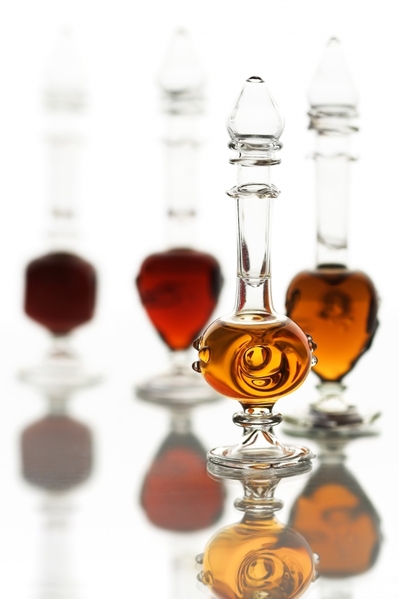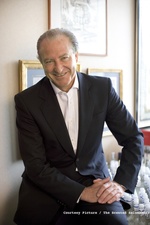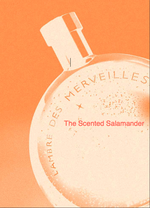Interview with Stephen Weller, IFRA Director of Communications: Fragrance Safety vs. Perfume Creation? {Perfume Q & A)
There have been many concerns expressed in the world of fragrance consumers - of fine fragrances in particular - about the regulatory activities of the International Fragrance Association or IFRA. We don't think we are too far off the truth when we say that this acronym has taken on a punitive connotation for many perfume lovers, including for professional perfumers...
On January 12th, 2010 an article in Le Monde by Nicole Vulser evoked the issues of restricted perfumery materials and the dangers those may create for the preservation of the patrimony of perfumery. Of course, it meant the French one more particularly and even more specifically that of perfumes signed by luxury brands owned by the LVMH group such as Dior and Guerlain, which are perceived as the standard-bearers of an Haute Perfumery tradition.
The action of IFRA is more often than not portrayed as that of a horse wearing blinkers which in order to enforce safety on fragranced products - and these include not just bottled scents actually but scented toys as well - is over-zealous in cutting out access to fine fragrance ingredients that are necessary to the survival of legendary perfumes such as Diorissimo and Mitsouko, the way we knew them to be. Après L'Ondée in extrait form, Parure, both by Guerlain, have been sacrificed as carefully composed and harmonious art forms with a unique sense of balance in answer to arguably legitimate public safety concerns although the historical data would point to a lack of observable epidemic patterns of perfume-related illnesses since the advent of Guerlain in 1828. As allergies are more and more triggered by environmental factors, that should be taken into account.
But one has to take those concerns seriously because for anyone interested in the history of beauty, one knows the horror stories of maimed limbs, blindness and early deaths due to the consumption of unregulated beauty products. .
If public health concerns are thus legitimate and may correspond to new global health patterns such as the rise of allergies, one might ask nevertheless if everything is done to preserve the cultural heritage of perfumery. If, in other words, perfumery is taken seriously enough to see it as an intellectual and artistic object, even without being able to prove this proposition in a timely manner. If there could not be a solution for continuing to wear a perfume in its vintage formulation just like we are able to breakfast on Cheerios with traces of peanuts in them despite the fact that it might represent a serious health threat to some.
It is worth remembering that reformulations are routinely made in the fragrance industry for reasons other than regulatory ones. Perfumes are in part dependent on harvests for example. Although one would cherish the thought of wearing exactly the same perfume over the decades, adaptations are often necessary and implemented. One historical example is the daffodil accord once recreated by Jean-Paul Guerlain for Vol de Nuit when the natural essence had been thrown inadvertently into the fire and no more could be had. The feat earned him the title of heir to the Guerlain dynasty of perfumers.
Perfumers have so far relied more on creative skills to combat palette restriction and misfortune than on political ones, but IFRA seems to be an obstacle that could be overcome, is perceived as somewhat arbitrary and its inner workings are not altogether clear to most
We wanted to clarify the consciousness of IFRA regarding these problems. Stephen Weller, its Director of Communications, kindly accepted to answer our questions in this initial exchange.
I am happy to report that there might be a glimmer of hope for the lost art of vintage perfumes.
Interview with Stephen Weller, IFRA Communications Director
- What is your background and how did you end up working in the perfume industry and at IFRA?
My background is as a Communications specialist for international trade bodies such as IFRA. I ended up working for IFRA because they were looking to recruit a full time professional Communications Director. The fragrance industry realised that it needed to be more transparent and proactive with its communication to stakeholders. The industry has a good story to tell regarding its responsible approach to global self-regulation and needs to make people more aware of it. I applied for this newly created position because the role itself intrigues me and also the fragrance industry is fascinating. It combines both scientific and creative talents, which is rare, very stimulating and fulfilling.
- How did IFRA come about? Could you tell us about the origins of this self-regulating body and how a need was perceived at the time for such an organization? When there was no IFRA how did the perfume industry function to protect consumers and its members?
IFRA was created in 1973 to administer the IFRA Code of Practice including IFRA Standards. Before this, in the early 60's the fragrance industry created the Research Institute for Fragrance Materials (RIFM) to carry out scientific research on fragrance materials on behalf of the entire industry to prevent several companies doing the same testing. Besides the economic benefits this ensured broad knowledge of the available safety data inside the industry and was an early step to prevent unnecessary and duplicate testing. The scientific research was needed because of concerns regarding the adverse properties of some of the ingredients and the need to ensure the good reputation of the industry and the safety of consumers.
- The 70s are also the decade in which animal ingredients in perfumery such as natural ambergris, musk, castoreum started fading away. To back track a bit, was IFRA instrumental in this development? Could you please explain your actions then if any?
IFRA was not directly involved in terms of setting Standards for animal derived ingredients. There is not really a safety issue with such ingredients. It is more of a social issue regarding cruelty to animals and the industry withdrew from using such materials voluntarily in response to society's concerns.
- How would you say your actions have had to adapt to the perfume industry of the 21st century? How do you keep up with the much more abundant data and launches? What are the ongoing and new issues in 2010?
IFRA has had to become more rigorous in proving the credibility of its self-regulatory approach over recent years. Hence, the introduction of the IFRA Compliance Program. The IFRA Compliance Program focuses on the safety of fragranced consumer products by ensuring that the IFRA Code of Practice is fully applied and adhered to. It involves the analysis of a variety of consumer products for the presence of fragrance ingredients regulated by IFRA Standards. The product analysis is defined in specific procedures and is coordinated completely independently by Eurofins Scientific, a leading international group of laboratories following strict internal procedures to ensure confidentiality and impartiality in each step of the program. The products are selected at random from the different categories - fragrance, cosmetics and toiletries and household and detergents - from ten randomly selected IFRA member countries each year.
No other industry voluntarily tests its products to ensure their Standards are adhered to. Not even regulatory authorities can do this consistently. This gives us a lot of credibility when having to deal with regulators and defend the industry as a whole.
Collectively the industry has also had to step up its research activities. The need for more and more data on materials is ever increasing. Various campaigning organisations regularly target groups of chemicals from phthalates to any Volatile Organic Compound or VOC, which can be portrayed as dangerous. Irrespective of the science proving these materials to be safe for their intended use in fragrances, there are regular studies released to the media stating the opposite. We need to respond to these and argue that our data is up to date, comprehensive and sound. Without a thorough, open and transparent scientific research program run through RIFM we would not be able to defend the use of fragrance materials.
Also, in Europe new chemical management legislation has just come into force called REACH, which stands for Review, Evaluation and Approval of CHemicals. This legislation means that every chemical used in Europe has to be registered with a central agency and adequate safety data provided. This legislation applies to all chemicals, be they natural or synthetic. The fact that the fragrance industry has a long history of developing and providing safety data actually helps the industry a great deal. Without it, fragrance materials would not be allowed to be used in Europe.
The level of scrutiny for the ingredients in any consumer product is very high across the world. It is the industry's collective responsibility to ensure that strong, sound science is in place to explain and defend the use of fragrance materials.
One of the biggest issues currently facing the industry is the push by legislators, especially in the USA, for full disclosure of fragrance formulae on the label of every product. As you can imagine this would firstly be very difficult since a fragrance formula can contain anything from 50 to 200 materials, which is not practical to put on a label. Secondly, the formula is confidential business information. A fragrance formula cannot be patented and is very expensive and difficult to copyright. Therefore, putting the formula on every product would seriously damage the industry's ability to perform.
- Allergies have become a much more widely recognized public health concern. Could you explain to us why IFRA and the perfume industry have set their preferences on perfume reformulation rather than warning labels as in the food industry? If we take inspiration from the pharmaceutical industry, why not deliver perfumes with allergenic ingredients in a controlled manner, again with warnings and perhaps even prescriptions? Fragrances are routinely sold in pharmacies. One would just need a step-up of this circuit of distribution.
There is a great deal of sympathy in the fragrance industry for some sort of new labelling approach, which would allow 'vintage' fragrances to remain available to the public. There are no concrete proposals for such an approach and it is fraught with difficulties, however, there could well be moves in this direction in the future.
Allergies in general are indeed on the increase and high on the agenda of public health officials. However, allergies to fragrances are decreasing thanks to the industry's responsible and collective approach to the problem. The approach is two pronged, labelling and reformulation. In Europe there is a list of 26 suspected allergens and if they are used in a fragrance over a certain limit then they have to be labelled so that a consumer can avoid certain materials. This is one approach to help inform the consumer to make a choice. However, not all consumers read labels or indeed understand the information on the label.
Therefore, IFRA Standards are needed to help reduce the incidents of sensitisation to certain materials. Experience shows that labelling alone does not have the desired effect.
- How do you look at economic parameters in your activities? Are you often lobbied to encourage the use of safer and cheaper ingredients? How is IFRA funded?
As a trade federation we represent the industry in regulatory fora around the world. We do not take part in any commercial activities and do not seek to influence any particular group of materials. Decisions to develop Standards are made by an independent panel of scientific experts and based purely on the science.
IFRA is funded by members of the fragrance industry. Membership includes large, medium and small companies and represents about 90% of the global volume of fragrance compounds produced. It is not an elitist organisation and we encourage non-members to follow the Code of Practice and Standards, which are available for free on our website.
- IFRA decided in December 2009 to specialize more in perfume as opposed to flavor which is now under the purview of EFFA. Why the felt need of this chasm? You have been critiqued in the past for being more unrelenting on the perfume industry than on the food industry as a way of supporting the argument that part of your actions may not be completely rational but based on habits of thinking. Common sense tells us that it would be hard to ban peanuts altogether or eggs at a global level based on allergenic reactions experienced by a portion of the population. Does this separation mean that you feel fragrances present specific problems in contrast to flavors?
IFRA has never represented the interests of the Flavour industry. Since its creation in 1973 its sole aim was to ensure the safe use of fragrance ingredients for the consumer and the environment. The European Flavour and Fragrance Association (EFFA) used to cover both elements because most of its members participated in both industry sectors. Traditionally national associations have combined both industries due to economies of scale. However, over recent years it has become clear that regulations for the two industries are increasingly separate. Different legislation, different departments, different scientific committees etc. It was therefore logical for EFFA to focus solely on flavours, where its specialisation lies and for IFRA to take on the role of European representation for fragrance, where its specialisation lies.
To your detractors who present you as unilaterally engaged in suppressing and narrowing down the palettes of perfumers, could you please cite examples of your actions that have contributed in expanding this palette or confirming its safety?
Oak Moss is an obvious example. Oak moss, when it comes to data about reactions observed in patients who went to a clinic, is still a very common trigger out of all fragrance ingredients. This is despite strict usage limitations. Oak moss is a complex mixture of many ingredients and research programs have tried to identify the most likely culprit for the sensitization properties. Two ingredients of oak moss have been singled out, and there is evidence that the reduction of those materials leads to an observable reduction in the sensitizing properties of the material. That is why a combination of measures has been implemented - a use level restriction and a purity requirement. It is hoped that these two measures combined will protect the continued use of this precious fragrance material.
IFRA has also spent a great deal of time, effort and money defending Polycyclic musks, citrus oil (furocoumarin) and Lyral, to name a few.
- What are the ingredients on which you consider you have had to change your position? Is the non-safe character of an ingredient (at a certain level) periodically reassessed in light of new research or does this information tend to be filed away for a long period of time?
In the IFRA process a regular review of the existing data (at least every 5 years) is foreseen. Just recently a material that had been banned because there was not enough data to carry out a risk assessment (Melissa oil) became permitted with certain restrictions in the light of new data.
Also, IFRA members can ask for a material to be reviewed if they think new data has come to light. Ultimately, it is the Expert Panel that decides on the data and whether or not a Standard should be applied.
- For how long is your panel of experts designated and how?
The panel has a rotation and tenure procedure. Potential members are interviewed by the panel, relative to scientific expertise and ability to contribute to fragrance safety evaluation. When a new panel member joins, there is a 3 year exploratory period, followed by two 5 year terms. So the total can be 13 years. The chair is elected for a 3 year term. All elections and member appointments are made by the panel.













"Safety issues" when it comes to perfumes allergens compared to the real dangers of the "wireless revolution", genetically modified foods, pesticides, carcinogenic bovine growth hormones? This sounds like a bunch of hypocritical bullshit to me!
I want the original En Avion, Narcisse Noir and Mitsouko back, I'm not buying the 2010 reformulations!! Even a masterpiece like Attrape-Coeur that was only -re-released five years ago has just been discontinued because of absurd IFRA restrictions!
Excellent Interview!
Mr. Weller,
1. It is the IFRA that sets the standards and variables under which chemicals are tested and the IFRA that writes the guidelines (even though the REXPAN has final review). IFRA votes are divvied up based on the percentage of dues paid by a member; how do you respond to critics describing IFRA as "privatized pay-to-play regulation"?
2. Why do the IFRA headquarters share the same address as Givaudan's Geneva headquarters? (a Swiss company that leads the world in fragrance market share)
I'm preparing a second set of questions for Mr. Weller so if anyone wants to ask further questions, please don't be shy and drop a line here or by email.
Splendid! Keep up the good work!
I will email in any other interesting questions but in the mean time:
1. The recently published list of ingredients used by IFRA members on the organization's website revealed the use of Strychnidin (CAS 4845-99-2, also known as brucine sulfate, a relative of strychnine with similar toxicity)as well as other moderately hazardous chemicals like Xylene, Diethylene glycol,Oxalic acid dihydrate, Piperidine and many others. None of these mentioned chemicals have any IFRA restriction despite some being transdermally absorbed or skin irritants (as well as being potential lethal). Why is the IFRA going after Oakmoss and Jasmine while ignoring real potential hazards?
2. IFRA's board of directors consists largely of employees from major fragrance firms.These same firms'sales of patented Oakmoss substitutes have skyrocketed after the 43rd Amendment's restrictions. Doesn't this present a conflict of interest, even for a voluntary regulation group?
Ziz,
Needless to say, thank you very much for your questions!
It's a plot by the big fragrance companies to maximize profits on chemical molecules over unpatented naturals.
Ziz - keep them coming!! All of your questions are bulls-eyes!!Let`s see how Mr. Weller dodges the darts this time...:-) M-H, THANK YOU for doing all the fine legwork!!
Linda,
Thank you for your kind words. Mr. Weller has promised to answer these questions or at least try to.
I encourage everyone that has a burning question to post it!